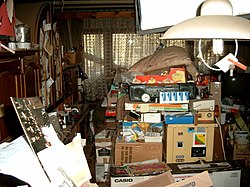Hoarding disorder

Editor-In-Chief: Prab R Tumpati, MD
Obesity, Sleep & Internal medicine
Founder, WikiMD Wellnesspedia &
W8MD medical weight loss NYC and sleep center NYC
| Hoarding disorder | |
|---|---|

| |
| Synonyms | N/A |
| Pronounce | N/A |
| Specialty | N/A |
| Symptoms | Difficulty discarding items, excessive accumulation of items, cluttered living spaces |
| Complications | Social isolation, health hazards, fire hazards, family strain |
| Onset | Typically begins in adolescence or early adulthood |
| Duration | Chronic |
| Types | N/A |
| Causes | Unknown, but may involve genetic, environmental, and neurobiological factors |
| Risks | Family history, stressful life events, personality traits |
| Diagnosis | Based on clinical assessment and DSM-5 criteria |
| Differential diagnosis | Obsessive-compulsive disorder, depression, schizophrenia, dementia |
| Prevention | N/A |
| Treatment | Cognitive behavioral therapy, medications |
| Medication | N/A |
| Prognosis | Variable; some improve with treatment, others may have chronic symptoms |
| Frequency | Estimated to affect 2-6% of the population |
| Deaths | N/A |

Hoarding disorder is a persistent difficulty discarding or parting with possessions because of a perceived need to save them. A person with hoarding disorder experiences distress at the thought of getting rid of the items. Excessive accumulation of items, regardless of actual value, occurs. Hoarding disorder can affect anyone, regardless of age, sex, or economic status.
Symptoms and Causes[edit]
The main symptom of hoarding disorder is the persistent difficulty discarding or parting with possessions because of a strong perceived need to save them. People with hoarding disorder feel distressed at the thought of getting rid of items, leading to an excessive accumulation that congests and clutters living spaces and significantly impairs their use. The hoarding is not attributable to another medical condition (e.g., brain injury, cerebrovascular disease). The exact cause of hoarding disorder is unknown. However, it is believed to be a complex disorder that results from a combination of genetic, developmental, neurobiological, and psychological factors. It often runs in families, suggesting a genetic predisposition.
Diagnosis and Treatment[edit]
Diagnosis of hoarding disorder is typically made based on an individual's symptoms, behavior, and history. The American Psychiatric Association's Diagnostic and Statistical Manual of Mental Disorders, Fifth Edition (DSM-5) includes criteria for diagnosing hoarding disorder. Treatment for hoarding disorder often involves psychotherapy, particularly cognitive-behavioral therapy (CBT), which focuses on changing the hoarding behaviors and the thoughts and emotions that contribute to them. In some cases, medications, such as selective serotonin reuptake inhibitors (SSRIs), may be used to help control symptoms, although medication is not considered as effective as psychotherapy for hoarding disorder.
Impact[edit]
Hoarding disorder can have a profound impact on individuals and their families. The disorder can lead to unsanitary conditions, fire hazards, and other safety risks. It can also cause significant emotional distress, impair social functioning, and lead to isolation.
See Also[edit]

This article is a psychology-related stub. You can help WikiMD by expanding it!
Ad. Transform your life with W8MD's Budget GLP-1 injections from $75


W8MD offers a medical weight loss program to lose weight in Philadelphia. Our physician-supervised medical weight loss provides:
- Weight loss injections in NYC (generic and brand names):
- Zepbound / Mounjaro, Wegovy / Ozempic, Saxenda
- Most insurances accepted or discounted self-pay rates. We will obtain insurance prior authorizations if needed.
- Generic GLP1 weight loss injections from $75 for the starting dose.
- Also offer prescription weight loss medications including Phentermine, Qsymia, Diethylpropion, Contrave etc.
NYC weight loss doctor appointmentsNYC weight loss doctor appointments
Start your NYC weight loss journey today at our NYC medical weight loss and Philadelphia medical weight loss clinics.
- Call 718-946-5500 to lose weight in NYC or for medical weight loss in Philadelphia 215-676-2334.
- Tags:NYC medical weight loss, Philadelphia lose weight Zepbound NYC, Budget GLP1 weight loss injections, Wegovy Philadelphia, Wegovy NYC, Philadelphia medical weight loss, Brookly weight loss and Wegovy NYC
|
WikiMD's Wellness Encyclopedia |
| Let Food Be Thy Medicine Medicine Thy Food - Hippocrates |
Medical Disclaimer: WikiMD is not a substitute for professional medical advice. The information on WikiMD is provided as an information resource only, may be incorrect, outdated or misleading, and is not to be used or relied on for any diagnostic or treatment purposes. Please consult your health care provider before making any healthcare decisions or for guidance about a specific medical condition. WikiMD expressly disclaims responsibility, and shall have no liability, for any damages, loss, injury, or liability whatsoever suffered as a result of your reliance on the information contained in this site. By visiting this site you agree to the foregoing terms and conditions, which may from time to time be changed or supplemented by WikiMD. If you do not agree to the foregoing terms and conditions, you should not enter or use this site. See full disclaimer.
Credits:Most images are courtesy of Wikimedia commons, and templates, categories Wikipedia, licensed under CC BY SA or similar.
Translate this page: - East Asian
中文,
日本,
한국어,
South Asian
हिन्दी,
தமிழ்,
తెలుగు,
Urdu,
ಕನ್ನಡ,
Southeast Asian
Indonesian,
Vietnamese,
Thai,
မြန်မာဘာသာ,
বাংলা
European
español,
Deutsch,
français,
Greek,
português do Brasil,
polski,
română,
русский,
Nederlands,
norsk,
svenska,
suomi,
Italian
Middle Eastern & African
عربى,
Turkish,
Persian,
Hebrew,
Afrikaans,
isiZulu,
Kiswahili,
Other
Bulgarian,
Hungarian,
Czech,
Swedish,
മലയാളം,
मराठी,
ਪੰਜਾਬੀ,
ગુજરાતી,
Portuguese,
Ukrainian